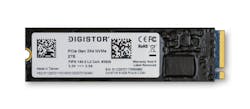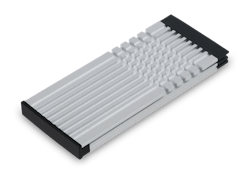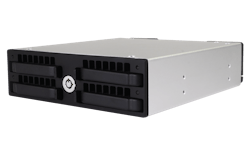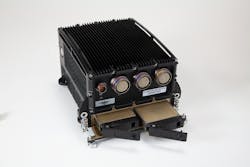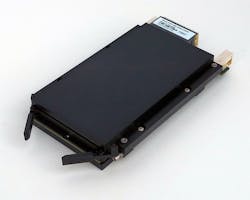NASHUA, N.H. - Rugged data storage technologies for aerospace and defense applications are making the transition from point-to-point interconnects to fast network-centric architectures that offer quicker data access to warfighters than they have today, and new shared-data applications such as artificial intelligence (AI) in intelligence gathering and retrieval.
Driving this trend to networked data storage are increases in network performance -- particularly fast Ethernet -- which is growing rapidly from 25 gigabits per second to 100 gigabits per second, and beyond.
"I'm seeing a move away from block-based direct-attached storage for external disk arrays," says Amos Deacon III, president of data storage specialist Phoenix International Systems in Orange, Calif. "We see a lot of moving to file-level storage in the realm of network-attached storage."
The switch to networked storage represents a fundamental shift away from industry stalwarts like Serial Attached SCSI"Traditionally we have had SAS and Fibre Channel connections in block based systems, and yet we are moving toward Ethernet for file-level data," Deacon says. File level data transfer typically is used in Ethernet-based data storage systems that move data as packets. "There typically is a lot of overhead involved," Deacon says.
This approach, while it has more overhead, is more simple to implement than other data-transfer approaches like Internet Small Computer Systems Interface (iSCSI), Fibre Channel, or SAS. "It comes down to simplicity and access," Deacon says. "More people can access it. Block level is a direct connect, and you have to be on that storage network to access it, while file level is a regular Ethernet network."
The high performance of Ethernet networking also is overcoming traditional network overhead problems. "Historically, block level is a lot lower latency because of the overheads involved, but that is starting to overcome because of the performance on the network-attached devices. Now we're talking about 25-, 40-, and 100-Gigabit Ethernet. That's giving the network attached devices much higher performance," Deacon says. "A lot of that inherent latency goes away."
Speed and performance can go a long way in new applications that involve AI. "Typically if you have a real-time environment you would want that data transfer to happen instantaneously, especially in an AI environment where you need to make decisions based on the data as it comes in. That typically has been a block-based direct-connect environment," Deacon says.
Is all that speed and performance really necessary in today's aerospace and defense applications? Perhaps not today, but it will in the future. "The performance that is available now with 100 Gigabit Ethernet is more than what 90 percent of the people out there need," Deacon points out. "There are specific applications that require super-high-speed capability, but I think it is the actual application that determines where that goes."
Today's high-performance data storage is seeing enhanced performance not only from Ethernet networking, but alsoNVMe data storage
Solid-state storage media today overwhelmingly leans toward NVMe, where the biggest advantage is pure speed, which for the vast majority of systems designers outweighs NVMe’s drawbacks in power consumption, thermal management, and ruggedization.
NVMe’s speed is the biggest reason that it has surpassed in popularity other solid-state storage media such as Serial AT Attachment (SATA) and Serial Attached SCSI (SAS). SATA is a computer bus interface that connects host bus adapters to data storage devices like hard disk drives, optical drives, and solid-state drives.
NVMe typically is six times faster than SATA and SAS. Moreover, the NVMe design approach enables data storage media such as solid-state drives to access processors via the PCI Express databus, rather than through relatively slow specialized data storage interfaces. It also enables host hardware and software to capitalize on levels of parallelism possible in modern solid-state drives. NVMe essentially connects data storage directly to system processors, and avoidsNVMe can increase data read and write speeds over SATA by four to five times — sometimes even more. As an example, SATA reaches its upper-speed limits at about 600 megabytes per second, while NVMe can sustain read and write performance of more than 3 to 3.5 gigabytes per second. One principle behind NVMe is switching from serial to parallel data interfaces to increase data throughput.
NVMe technology can record several streams of video or other sensor data simultaneously. Aerospace and defense applications increasingly rely on speed and the ability to record multiple data streams simultaneously. For I/O-intensive applications like artificial intelligence (AI) NVMe devices speed-up workflows.
The PCI Express interface for NVMe is gaining widespread popularity in aerospace and defense applications. NVMe data storage bypasses the SATA interface and goes directly to PCI Express to boost throughput speeds.
In addition to its big advantages in speed, NVMe also is smaller than SATA and SAS, which lends itself to today’s demands for small size and light weight in aerospace and defense systems. NVMe solid-state drives are much smaller than SATA drives and weigh about four times less, which makes them suitable not only for laptop computers, but also for size- and weight-sensitive military applications. In addition, systems designers can attach NVMe memory components directly to motherboards and single-board computers, which also can cut down on size and weight.
NVMe memory is not as rugged as SATA and SAS data storage, which can increase the challenge of packaging NVMe for mobile military applications that must operate in extreme temperatures, shock, and vibration.
One of the most serious weaknesses of NVMe for rugged military applications is its relatively weak ability to operate in cold and hot temperatures. Compounding the picture is the relatively high power consumption of NVMe vs SATA and SAS storage media. More power consumption means generating more waste heat, which forces designers either to design-in cooling, or throttle-down the speed of the data storage to keep within temperature constraints.
Information security
In today's adversarial digital world, it matters less how quickly data can be stored and retrieved than it does how secure the data can be kept from those who seek to steal it, corrupt it, or destroy it. That's where information security comes in.
Unfortunately some of today's cyber security technologies may not be up to the information security challenge where data storage is concerned.
"The data security model today is quite fractured, if not broken," says Chris Kruell, director of marketing, at the DIGISTOR brand of CRU Data Security Group in Vancouver, Wash. "All these technologies are taking on a piece of the data security issue."
Perhaps the most important aspect of information security for data storage is the so-called "zero-trust" concept, which"Insider threats haven't been a topic of conversation, even five years ago as much as it is today," Kruell says. "It is basically saying you can't trust anyone or anything, so you need to focus on locking down your data," Kruell says. "We are seeing greater and greater adoption of a zero-trust philosophy."
Although zero-trust may sound new, it's actually be around for the past 10 or 15 years; it's just now that it's becoming widely known and accepted, Kruell says, explaining that it takes time for zero-trust to catch on -- especially since this discipline is so demanding.
"It comes down to people and processes," Kruell says. "Do people have the discipline to follow processes, and do you know that the guy in the cubicle beside you is not a threat? This was accelerated by cyber attacks that come from inside a network or physical perimeter; that attack has a good chance of succeeding. That threat could be anywhere, even next door."
CRU Data Security specializes in self-encrypting data storage drives, and takes advantage of today's high-speed data storage networking. "A lot of our devices go into aircraft that capture surveillance data," Kruell says. "You can never capture or analyze data fast enough, and you always want a cocoon of security."
To achieve that cocoon of security, CRU Data designs data drives according to Federal Information Processing Standard (FIPS) 140-2 and the Advanced Encryption Standards (AES) outlined in FIPS 197. These commercial-level encryption standards are administered by the U.S. National Institute of Standards and Technology (NIST) in Gaithersburg, Md.
Company engineers also used layered software to go alongside FIPS-certified drives to enhance security. "Our customers are asking for additional cyber security functions beyond the drive itself," Kruell says. "In this market, self-encrypting drives are table stakes."
CRU Data also is pursuing secure data storage that meets guidelines of the National Security Agency (NSA) Common Criteria for Information Technology Security Evaluation, administered by the NSA’s National Information Assurance Partnership (NIAP). Common Criteria certification also is one of the first steps toward implementing the NSA’s Commercial Solutions for Classified (CSfC) two-layer encryption for protecting classified information in aerospace and defense applications.
CRU Data doesn't yet offer a security data storage device that meets all the guidelines of CSfC, but Kruell says he wouldn't be surprised" to see the company offer a full CSfC solution in the near future.
Who's who in rugged data storage
Aitech Defense Systems
Chatsworth, Calif.
www.rugged.com
Annapolis Microsystems
Annapolis, Md.
https://www.annapmicro.com
Barracuda Networks
Campbell, Calif.
www.barracudanetworks.com
Cavium Networks
San Jose, Calif.
www.caviumnetworks.com
CP Technologies LLC
San Diego
https://cp-techusa.com
CRU Data Security Group LLC, DIGISTOR
Vancouver, Wash.
www.cru-inc.com
Crystal Group
Hiawatha, Iowa
www.crystalrugged.com
Conduant
Longmont, Colo.
www.conduant.com
Curtiss-Wright Defense Solutions
Ashburn, Va.
www.conduant.com
DRS Tactical Systems Inc.
www.leonardodrs.com/products-and-services/leonardo-tactical-systems
Elma Electronic Inc.
Fremont, Calif.
www.elma.com
Extreme Engineering Solutions
Verona, Wis.
www.xes-inc.com/about/contact/
General Micro Systems
Rancho Cucamonga, Calif.
www.gms4sbc.com
Kaman Fuzing & Precision Products
Middletown, Conn.
www.kaman.com/fuzing-precision-products
Kontron America Inc.
San Diego
www.kontron.com
Mercury Systems
Andover, Mass.
www.mrcy.com
Pentek Inc.
Upper Saddle River, N.J.
www.pentek.com
Phoenix International
Orange, Calif.
www.phenxint.com
Smart Modular Technologies
Newark, Calif.
www.smartm.com
Systel Inc.
Sugar Land, Texas
http://www.systelinc.com
Trusted Computing Group
Beaverton, Ore.
https://trustedcomputinggroup.org
Virtium LLC
Rancho Santa Margarita, Calif.
www.virtium.com
ZMicro
San Diego
https://zmicro.com

John Keller | Editor-in-Chief
John Keller is the Editor-in-Chief, Military & Aerospace Electronics Magazine--provides extensive coverage and analysis of enabling electronics and optoelectronic technologies in military, space and commercial aviation applications. John has been a member of the Military & Aerospace Electronics staff since 1989 and chief editor since 1995.

